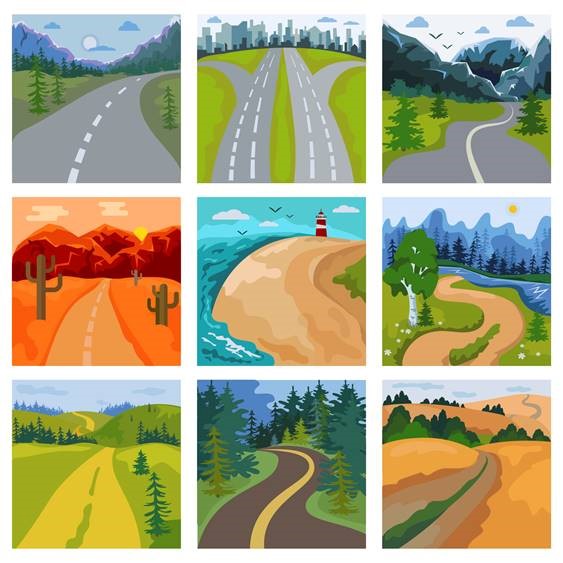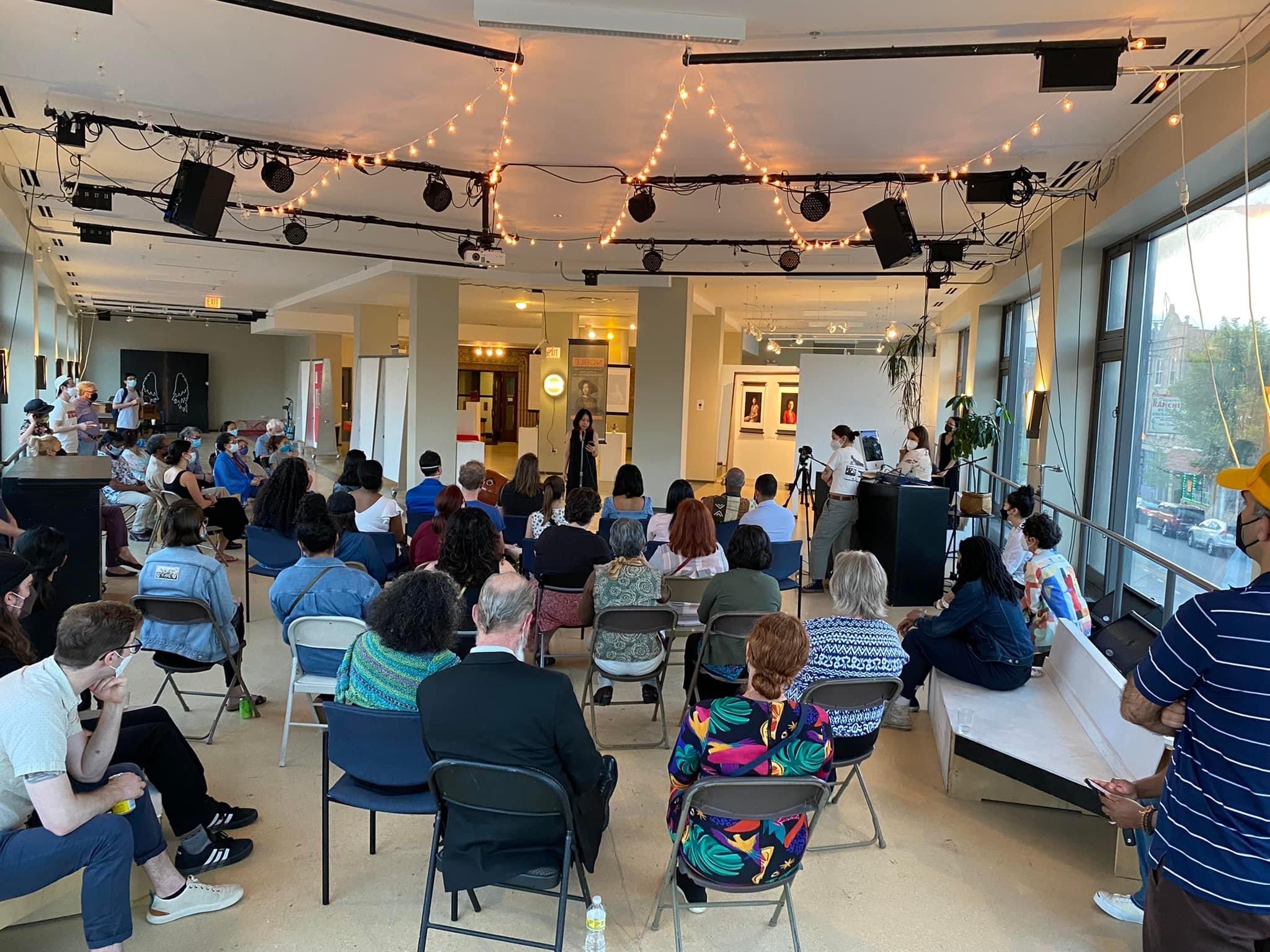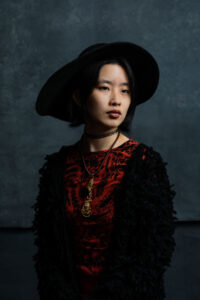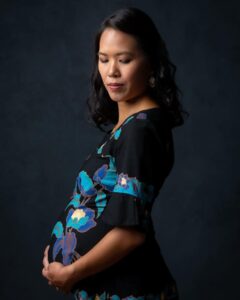



By Leslie Farrell
“O SON OF SPIRIT! Noble have I created thee, yet thou hast abased thyself. Rise then unto that for which thou wast created.” Inspiration from this passage in the Hidden Words compelled photographer Nancy Wong to create a series of portraits of Asian Americans demonstrating their beauty, humanity and nobility.
In fact, Noble is the title of her exhibit, which premiered in 2022 at the Hairpin Arts Center in Chicago. Wong shared her thoughts about the exhibit shortly after returning from Haifa, Israel, where she and other photographers documented the 13th International Bahá’í Convention.
“I’d always wanted to do portraits of Asian women but I’d put it on the back burner,” Wong says. Then at the start of the pandemic, violent acts against Asians in the United States prompted her to take action with her camera, “especially when six Asian women were killed in Atlanta [in 2021]. I needed to express or process and focus on the nobility of human beings.”

The Atlanta shooter’s statements to police indicated that he saw the Korean women as representing immorality. Wong notes that Chinese women in the 1800s in the United States were viewed similarly. She felt public sentiment had encouraged some people to scapegoat Asian Americans, as had been done throughout U.S. history—evidenced by laws such as the 1875 Page Act prohibiting Chinese women from entering the country and the 1882 Chinese Exclusion Act, as well as the 1942 executive order to place Japanese Americans in internment camps.
Still, Wong says she created this exhibit of photographs not because of current events, but alongside them. “And, truth is, I just wanted to make some art that showcased Asians. Not all art made by Asian artists needs to be about the pain and suffering we experience. I knew this project would involve what I am wondering about: how do we manifest the spiritual reality in the world that we are essentially and fundamentally one?”
To create photos for this exhibition, she rented studio space in both Chicago, where she lives, and Minneapolis, where she has ties. Her subjects represented lineage from Japan, Malaysia, Pakistan, India, Bangladesh, Korea, Thailand and China.
Wong says she looked up the definition of “noble” because she believed it meant more than the surface meaning of being associated with royalty. “I learned that its meaning, in the context of what Bahá’u’lláh tells us, is related more to qualities such as refinement, goodness, righteousness, honor, beauty, decency, worthiness,” she says. “I wanted the portraits to be elegant and to express that nobility. I read that in the art world what is exhibited is what is considered valuable. My hope was to say we have a place, a right to be here,” says Wong, whose ancestry is Chinese.
The idea that all human beings are created noble, she reasons, should make us question, “Why have we abased ourselves by committing such violence and brutality towards each other?”
Her goal with Noble was to “utilize the genre of portraiture to interrogate the historical invisibilization and marginalization of Asian Americans while using basic elements of the portrait, such as light and composition, to impart each subject’s unique and beautifully complex individuality.”
Historically in art exhibitions, “A displayed portrait is often a proof of life and existence, a sign of power and prestige, an affirmation of privilege and status, a proclamation of legitimacy and value,” she says. “Those seen in these galleries are to be coveted, made holy and sacred, and remembered in history. Noble is a gesture of legitimacy, value, importance, beauty, and recognition of my subjects, as people of Asian descent in the U.S.A.”
When beginning the project, she took guidance from the Universal House of Justice’s encouragement of engaging in a learning mode of prayer, meditation, consultation, action and reflection. “I told myself it was okay to start small, but I just needed to start,” says Wong. In contrast with the fast pace of most freelance photography, “I wanted to do more work that would be slower paced, giving me time and room to create in the studio.”
Mindful about who she invited to be photographed, Wong took care to include a variety of age, ethnicity, spiritual practice, professional training and education. She invited subjects to wear whatever they chose and to bring an object of their choosing that was symbolic of being Asian American. “I wanted them to be human, just people who happen to have this ethnic background,” she says.


Sarih Leng, a subject in Wong’s project, says, “To have an array of diverse Asian ethnicities represented in a photo exhibition is unprecedented, and I sincerely hope viewers of the Noble series find that one person cannot simply be categorized with the general overarching label of being ‘Asian.’”
Leng, a Milwaukee-area resident whose Singaporean heritage includes a blend of Cantonese and Malay (Hokkien) ethnicities, adds that there is a definite need that projects such as this address. “I feel that Asian-Americans are often overlooked and our presence diminished,” she says. “Every May, Asian-American and Pacific Islander heritage month–the only time when American society can start to take notice of the AAPI community–largely goes uncelebrated where I live.”
Wong was surprised that the project generated so much interest. “The hope of any artist is that there will be interest, but I liked that regardless of their [the viewer’s] race, they got what I was trying to do. The general population was interested.” Also, everyone she asked to photograph enthusiastically agreed.
Pictures permeate our lives, transcend language, and have power to build empathy, Wong reflects. “I regard this project as a process of helping others to see and understand, cultivating our collective emotional capacity to accept those who happen to look like me, and for whom we’ve been taught to see as the perpetual foreigner. These portraits are a way to celebrate my photo subjects and to honor them, while also acknowledging their families and ancestors. They remind us that Asian Americans are not two-dimensional; that we are whole, dynamic, creative, innovative, adaptive, simple, complex, beautiful, and noble.”


![]()
![]()
Whether you are exploring the Bahá'í Faith or looking to become an active member, there are various ways you can connect with our community.
Please ensure that all the Required Fields* are completed before submitting.